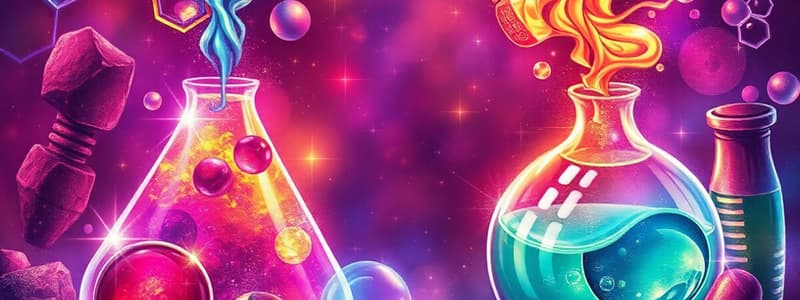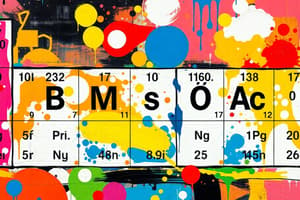Podcast
Questions and Answers
An element is described as being a good conductor of electricity, shiny, and ductile. It also has a high melting point. Which group does this element most likely belong to?
An element is described as being a good conductor of electricity, shiny, and ductile. It also has a high melting point. Which group does this element most likely belong to?
- Transition Metals (correct)
- Alkali Metals
- Halogens
- Alkaline Earth Metals
Consider a molecule with the formula $H_2SO_4$. Which of the following statements accurately describes its composition regarding elements, atoms, molecules and compounds?
Consider a molecule with the formula $H_2SO_4$. Which of the following statements accurately describes its composition regarding elements, atoms, molecules and compounds?
- It consists of two elements, is one atom, and forms a compound.
- It consists of four elements, is one atom, and forms a molecule.
- It consists of one element, is multiple atoms, and forms a molecule.
- It consists of three elements, is multiple atoms, and forms a compound. (correct)
Element X has 17 protons. How many periods does Element X occupy and which group does it belong to on the periodic table?
Element X has 17 protons. How many periods does Element X occupy and which group does it belong to on the periodic table?
- Period 2, Group 17
- Period 3, Group 1
- Period 2, Group 1
- Period 3, Group 17 (correct)
An atom has an atomic number of 8 and an atomic mass of 16. What is the number of protons, neutrons, and electrons in this atom?
An atom has an atomic number of 8 and an atomic mass of 16. What is the number of protons, neutrons, and electrons in this atom?
Which of the following elements is most likely to be found in a gaseous state at room temperature and is known for its inertness?
Which of the following elements is most likely to be found in a gaseous state at room temperature and is known for its inertness?
Which statement accurately differentiates between elements, compounds, and mixtures?
Which statement accurately differentiates between elements, compounds, and mixtures?
Consider a sealed container holding only hydrogen ($H_2$) gas. Which classification best describes the contents?
Consider a sealed container holding only hydrogen ($H_2$) gas. Which classification best describes the contents?
How does the formation of a compound typically affect the properties of its constituent elements?
How does the formation of a compound typically affect the properties of its constituent elements?
What is the primary purpose of the periodic table?
What is the primary purpose of the periodic table?
If element X has an atomic number of 8, to which element does it correspond, and what is a notable property associated with its group?
If element X has an atomic number of 8, to which element does it correspond, and what is a notable property associated with its group?
Which option accurately describes the composition of carbon dioxide ($CO_2$)?
Which option accurately describes the composition of carbon dioxide ($CO_2$)?
A chemist has two beakers, one with saltwater and the other with sand and water. Which statement accurately describes these?
A chemist has two beakers, one with saltwater and the other with sand and water. Which statement accurately describes these?
If a new element is discovered with 118 protons, how would the periodic table help predict its properties?
If a new element is discovered with 118 protons, how would the periodic table help predict its properties?
Flashcards
Periods
Periods
Horizontal rows in the periodic table; elements share electron configuration patterns.
Alkali Metals
Alkali Metals
Group 1 elements; highly reactive metals like Sodium (Na).
Metalloids
Metalloids
Elements with properties of both metals and non-metals, like Silicon (Si).
Atoms
Atoms
Signup and view all the flashcards
Protons
Protons
Signup and view all the flashcards
What are Elements?
What are Elements?
Signup and view all the flashcards
What are Compounds?
What are Compounds?
Signup and view all the flashcards
What are Mixtures?
What are Mixtures?
Signup and view all the flashcards
Homogeneous Mixture
Homogeneous Mixture
Signup and view all the flashcards
Heterogeneous Mixture
Heterogeneous Mixture
Signup and view all the flashcards
What are Molecules?
What are Molecules?
Signup and view all the flashcards
How are Molecules Formed?
How are Molecules Formed?
Signup and view all the flashcards
Periodic Table's Purpose
Periodic Table's Purpose
Signup and view all the flashcards
Study Notes
- Substances are classified as elements, compounds, or mixtures, based on their composition and bonding.
Elements
- Elements consist of only one type of atom and cannot be broken down into simpler substances.
- Examples of elements include Oxygen (O), Hydrogen (H), and Gold (Au).
Compounds
- Compounds consist of two or more different types of chemically bonded atoms.
- Examples include Water (H₂O), Carbon Dioxide (CO₂), and Sodium Chloride (NaCl).
Mixtures
- Mixtures are combinations of two or more substances that are not chemically bonded.
- The components of mixtures can be separated by physical means.
- Homogeneous mixtures have evenly distributed components, for example, saltwater.
- Heterogeneous mixtures have unevenly distributed components, for example, salad, or oil and water.
Distinguishing Elements, Compounds, and Mixtures
- Elements contain a single type of atom.
- Compounds contain two or more different atoms chemically bonded.
- Mixtures are physical combinations of substances without chemical bonding.
Molecules
- Molecules consist of a group of two or more atoms bonded together, which can be the same or different elements.
- Examples of molecules include O₂ (oxygen), H₂O (water), and CO₂ (carbon dioxide).
Distinguishing Elements, Molecules, and Compounds
- Elements consist of only one type of atom.
- Molecules are a group of atoms bonded together, which can be the same or different types of atoms.
- Compounds are a type of molecule made from different types of atoms chemically bonded together.
Formation of Compounds and Molecules
- Atoms form molecules by sharing or transferring electrons.
- Compounds are formed when atoms of different elements chemically bond, such as H₂O formed from hydrogen and oxygen.
Properties of Compounds vs. Component Elements
- Compounds often exhibit completely different properties from their constituent elements.
- Sodium (Na), a highly reactive metal and Chlorine (Cl), a poisonous gas, combine to form Sodium Chloride (NaCl), common table salt.
Purpose of the Periodic Table
- The periodic table organizes all known elements by atomic number and properties.
- The periodic table helps predict element behaviors and relationships.
Identifying Elements using Atomic Number
- Each element is assigned a unique atomic number, equivalent to the quantity of protons.
- The atomic number determines the element’s position in the periodic table.
Groups and Periods
- Groups are vertical columns in the periodic table; elements in the same group have similar properties.
- Periods are horizontal rows; elements across a period have varying properties but share electron configuration patterns.
Group Names & Element Types
- Alkali metals (Group 1) are highly reactive metals, such as Sodium.
- Alkaline Earth metals (Group 2) are reactive metals, such as Calcium.
- Transition metals are less reactive metals, such as Iron and Copper.
- Halogens (Group 17) are non-metals and highly reactive, such as Chlorine.
- Noble gases (Group 18) are inert gases, such as Helium and Neon.
Real-Life Applications
- Gold (Au) applications: jewelry and electronics.
- Iron (Fe) applications: construction and manufacturing.
- Oxygen (O) applications: breathing and combustion.
Metals vs. Non-Metals
- Metals conduct electricity, are shiny, malleable, and ductile.
- Non-metals are poor conductors, brittle in solid form, and often gases or liquids.
Properties of Alkali Metals, Transition Metals, Metalloids, & Noble Gases
- Alkali Metals: Very reactive, soft metals that conduct electricity.
- Transition Metals: Hard, have high melting points, and conduct electricity.
- Metalloids: Exhibit properties of both metals and non-metals, such as Silicon.
- Noble Gases: Inert, non-reactive, colorless gases.
Distinguishing Atoms, Molecules, & Compounds
- Atoms are the basic units of matter.
- Molecules are combinations of atoms bonded together.
- Compounds are specific molecules made of different types of atoms bonded together.
Drawing Molecular Models
- Molecular models of simple molecules such as O₂, CO₂, and H₂O visually show how atoms bond.
Identifying Constituent Elements
- Carbon (C) and Oxygen (O) are the constituent elements in CO₂.
Atomic Structure
- Subatomic Particles: Protons, Neutrons, and Electrons.
- Protons: Positive charge, and located in the nucleus.
- Neutrons: Neutral charge, and located in the nucleus.
- Electrons: Negative charge, orbit the nucleus.
Atomic Number and Mass
- Atomic Number: The number of protons in the atom.
- Atomic Mass: The sum of protons and neutrons.
- Carbon (C) has an atomic number of 6 (6 protons) and an atomic mass of about 12 (6 protons + 6 neutrons).
Studying That Suits You
Use AI to generate personalized quizzes and flashcards to suit your learning preferences.





